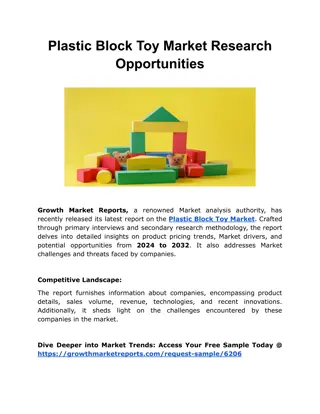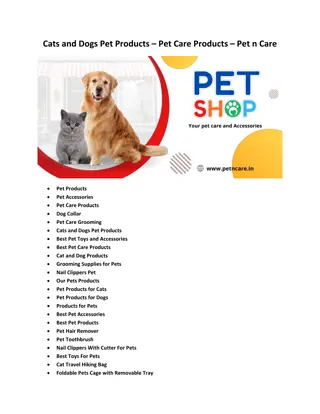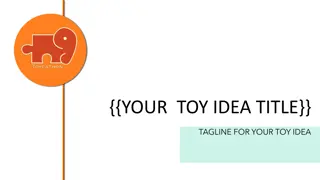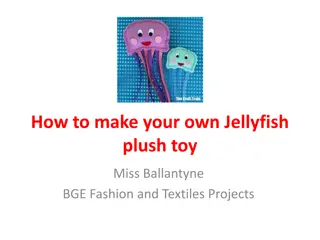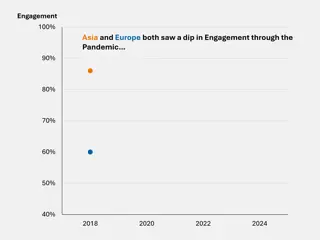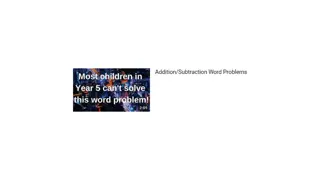Insights into the Shifts in Toy Buying Trends Amidst the Pandemic
The US toy industry saw contrasting trends in Q1 2020, with a notable increase in online sales and a decline in physical store sales. Parents focused on entertaining kids at home, leading to surges in sales of outdoor toys, art supplies, and educational materials. Targeting Millennials and Baby Boomers as key toy-buying demographics presents a lucrative opportunity. Popular toys during the pandemic included classics like board games and Lego, alongside trendy items like L.O.L. Surprise! and Pok.mon. Advertisers adapted strategies to capitalize on the growing demand for toys during the pandemic.
Download Presentation

Please find below an Image/Link to download the presentation.
The content on the website is provided AS IS for your information and personal use only. It may not be sold, licensed, or shared on other websites without obtaining consent from the author.If you encounter any issues during the download, it is possible that the publisher has removed the file from their server.
You are allowed to download the files provided on this website for personal or commercial use, subject to the condition that they are used lawfully. All files are the property of their respective owners.
The content on the website is provided AS IS for your information and personal use only. It may not be sold, licensed, or shared on other websites without obtaining consent from the author.
E N D
Presentation Transcript
A Tale of Two Toy-Buying Channels According to The NPD Group, total Q1 2020 sales for the US toy industry increased 7.6% to $3.6 billion, compared to Q1 2019; however, at hobby, toy and game stores (NAICS 45112), Q1 2020 sales decreased 7.3% to $3.19 billion from Q1 2019 s $3.44 billion. The very significant gap from these two data sources clearly indicates consumers were spending much more for hobby, toy and game products online. In fact, Rakuten Intelligence reported a 119% increase in toys and games purchases online 3/2 4/12/20. April 2020 was the low point for hobby, toy and game stores, as sales plummeted 69.7% from March 2020 and 68.7% from April 2019; however, May 2020 sales rebounded spectacularly to $1.1 billion, a 210.9% increase from April, and only -0.9% from June 2019.
The Kids Are Alright, If Theyre Entertained With schools closed and many parents working remotely, especially during March and April, entertaining children was a top priority. The NPD Group reports April 2020 sales of outdoor and sports toys increased 51% YOY, and accounted for 53% of all of April s increase. Home schooling drove an 18% increase in standard school supplies. Sales of coloring and art merchandise increased 86%, with crayons, children s watercolors and colored pencil sets each increased by triple-digits. Just during the week ending March 21, total toy sales increased 26%, with the games/puzzles sub-category increasing the most, or 228%. Children s nonfiction books increased 66%, with language arts/handwriting first at +265%.
Two Very Prime Markets to Target The retail toy channel enjoys an almost unprecedented historical moment when the two generations, Millennials and Baby Boomers, who are most likely to buy toys, are the two largest generations, or 72.1 million and 71.6 million, respectively, as of July 2019. As of April 2019, Baby Boomers had twice the total household wealth of Millennials, or 54% and 22%, respectively, and Baby Boomers spend approximately $3.2 trillion per year. According to the Pew Research Center, 83% of all adults 65+ are grandparents. Although Millennials were late to marry and start families, more than half of all children in the US have Millennial parents, and approximately 62% of those children are infants or preschool-aged.
Toy Mania Other highlighted toys during the pandemic stay-at-home period were classic board games, such as Monopoly, Game of Life and Operation; however, the kidult trend was also evident with adults using their extra time to build with Lego. The NPD Group s report of Q1 2020 US toy sales listed L.O.L. Surprise!, Pok mon, Disney Frozen, Barbie, Star Wars, Marvel Universe, Hot Wheels, Nerf, Funko Pop! And Little Tikes has the top 10 toys, which collectively increased 19%. Five of the top toys previewed at the January 2020 Toy Fair targeting the 2020 holiday season were Minecraft Earth Boost Minis, Disney Hocus Pocus: The Game, American Girl VW Surf Bus, The Child & the Mandalorian Brickheadz and The Feel Better Box.
Advertising Insights The sales increases for various toy categories, both children s and adult s, with the start of the pandemic, motivated toy companies and retailers to spend collectively 13 times as much for advertising from the week of January 6th to the week of March 23rd. According to data from Media Radar, from February to March 2020, Mattel spent more than 14 times on advertising, Hasbro more than 6 times, Lego more than 5 times, Playmates Toys more than 3 times and Spin Master more than 2 times. Of course, consumers were buying most of those toys online from Amazon, Target and Walmart. Of the average weekly ad spending of almost $16 million during March, 89% was allocated to promoting children s toys.
Cautious Toy-Store Shoppers Fat Brain Toys surveyed 400 of its customers during the 6 months through May 2020 who made a purchase in one of its locations across Kansas and Nebraska, which serves as a microcosm of toy-store shoppers attitudes during the pandemic. A majority said they been shopping more online in all categories, or 41.9% significantly more and 38.9% a little more. Almost 25% (23.9%) said I think I ll permanently be doing more online shopping ; the other 76.1% prefer my old way of shopping. Only 21.4% said I m ready to shop as soon as store re-open, 48.4% answered I ll shop if needed, but I m in no hurry and 30.2% said I ll wait until I feel it s safer to shop.
Advertising Strategies Using TV to target grandparents as toy buyers can be very effective, especially if they are able to assist their adult children with spending who may have been furloughed or became unemployed. If many students can t return to fall classes, then toys, learning toys, specifically, will be top-of-mind for many parents not only to supplement a very different school season, but also to continue to provide diversions, especially if more parents are working remotely. Based on the early-pandemic home schooling experience, toy stores will want to add more art merchandise to their inventories and promote and advertise them aggressively, as per the contents of slide #3 and the matching table on page 2 of the Profiler.
New Media Strategies Now may be the time for local toy stores to recruit/incentivize influencers, especially local families with multiple children. With parental supervision, the children could test a number of new toys and the family could collectively post short review videos on social media. Social media may be an excellent channel to benefit from the kidult trend, as adults turned to building sets, such as Lego, during the early-pandemic period. Ask adults to share what they built in short videos and how it helped to reduce stress. All indications is that more holiday season shoppers will be buying online, so local toy stores may want to create online catalogs to generate more e-commerce sales as well as initiate and promote BOPIS and/or delivery services.


